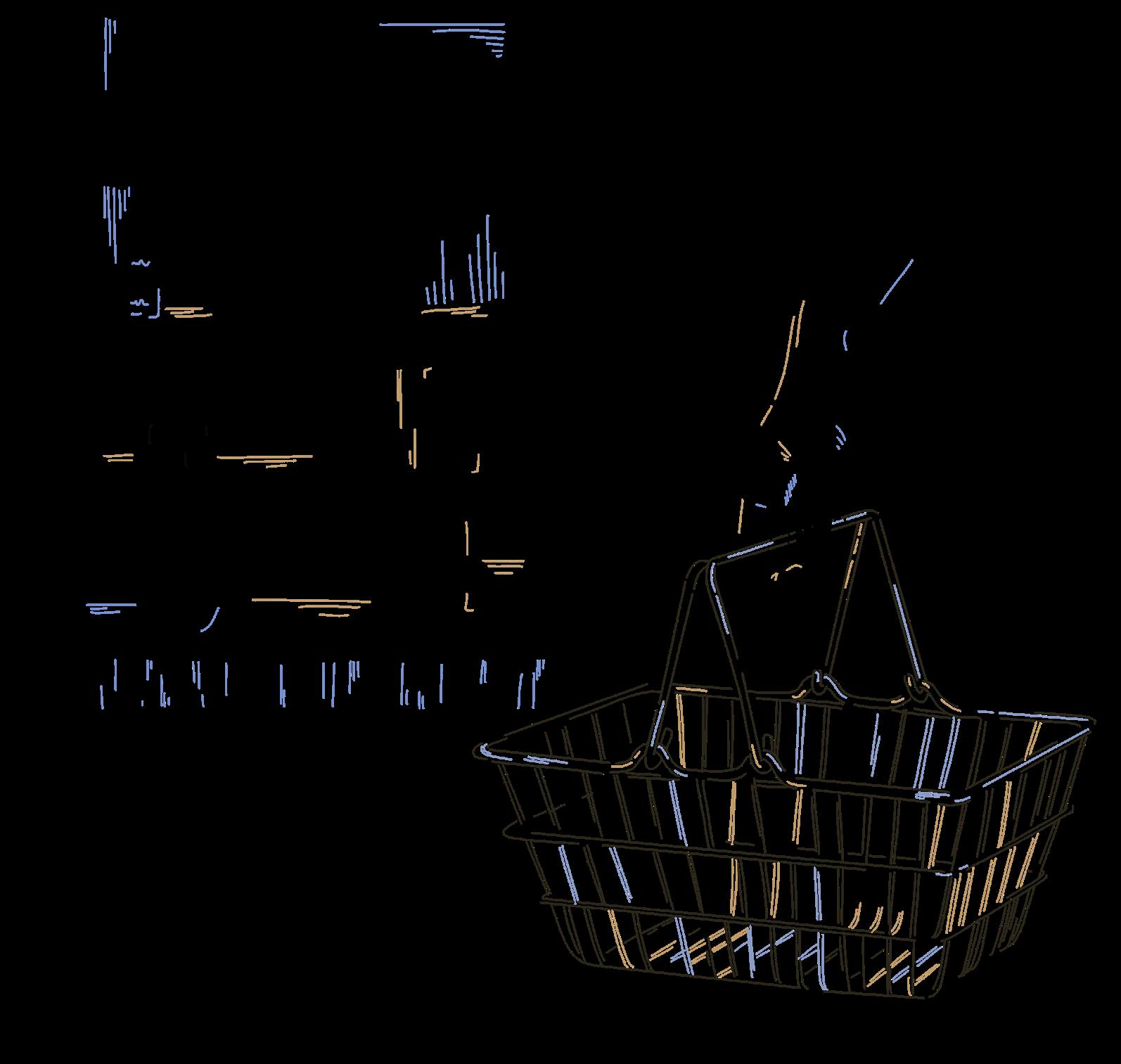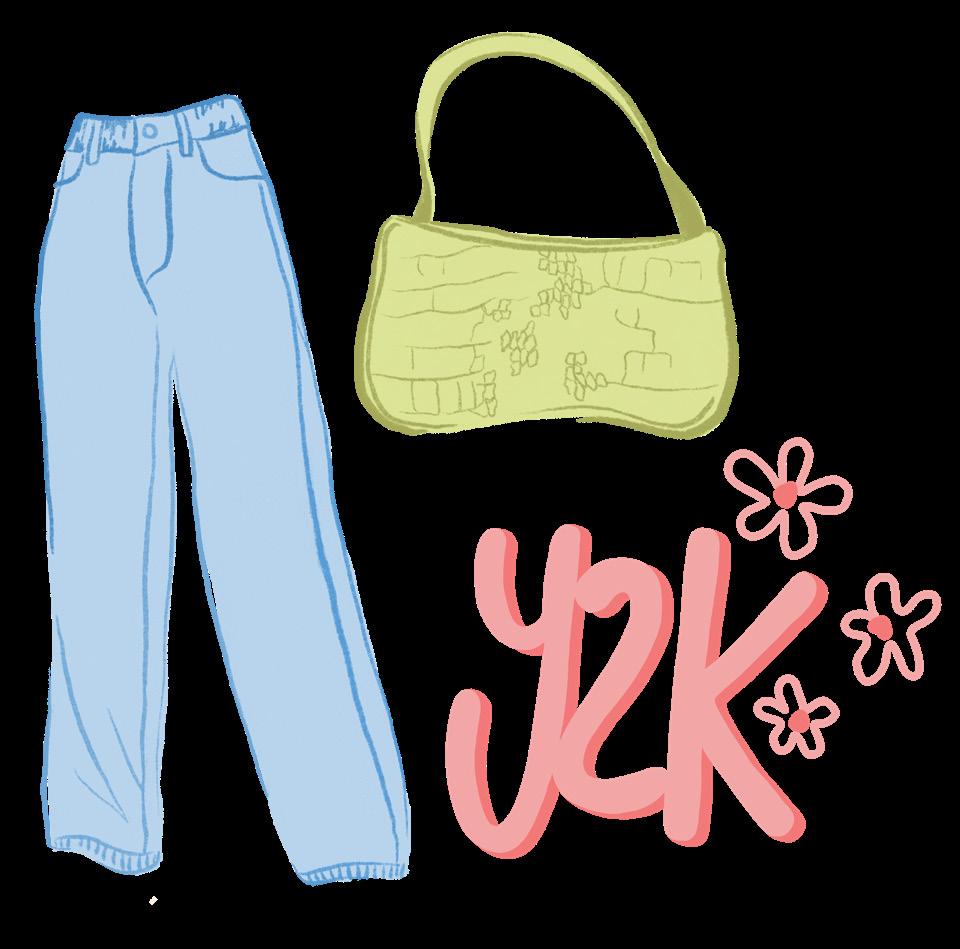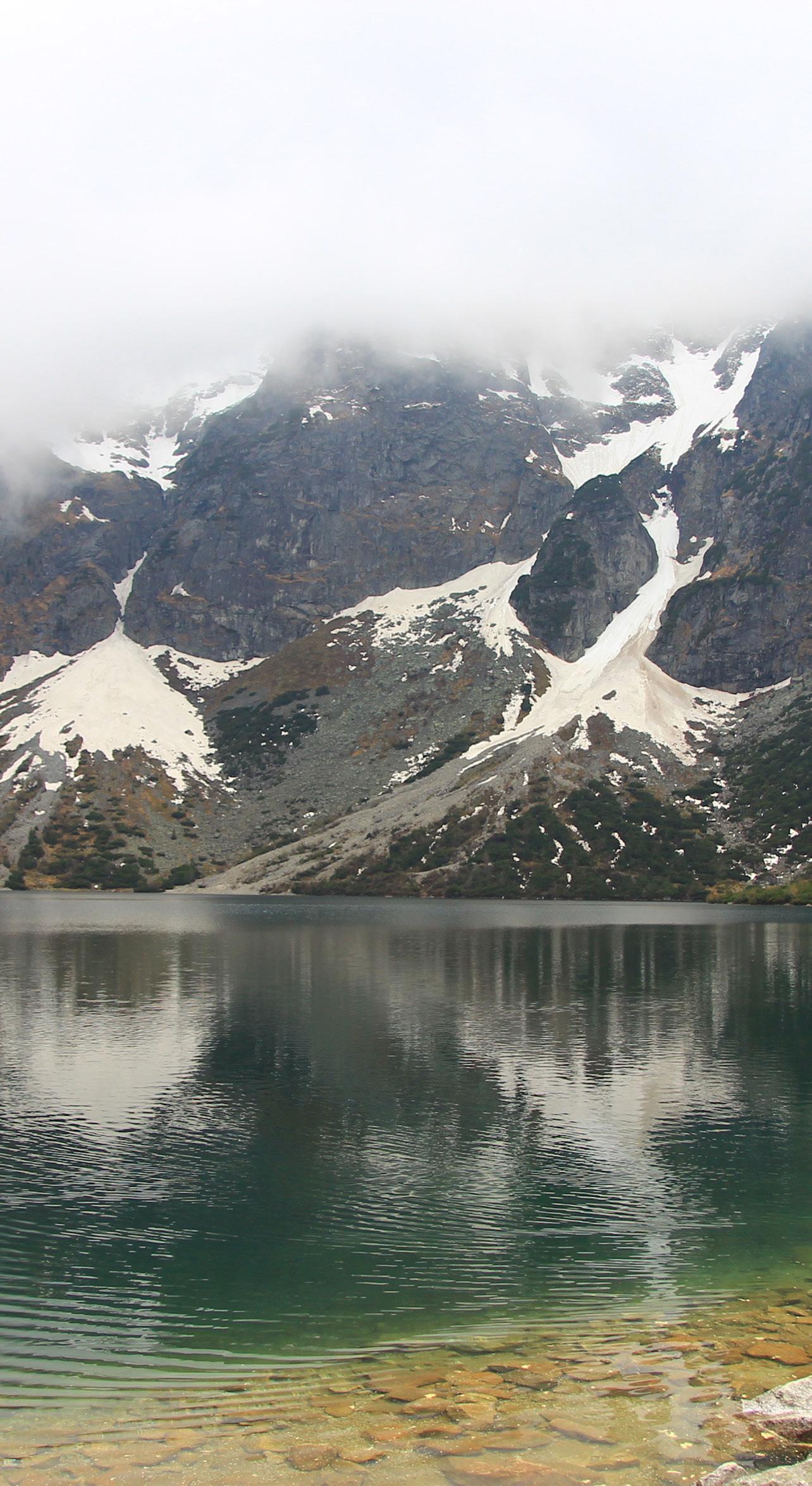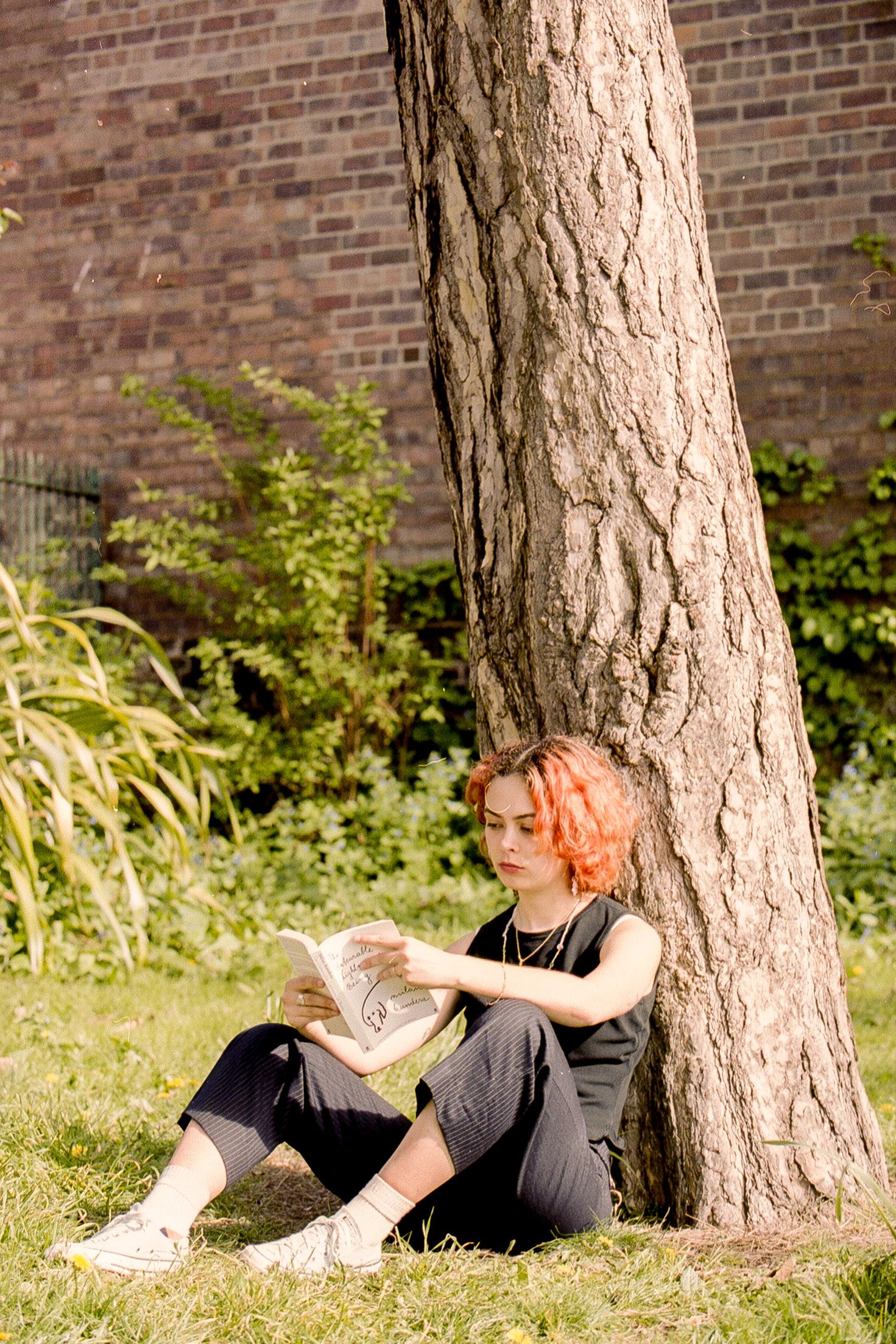
22 minute read
Waste not Want not
from Issue 266 - Us
IMPACT Waste Not Want Not
Did we develop a more sustainable relationship with food in the pandemic? Hannah Sutton investigates.
When the pandemic began in early 2020, panic set in for many people; visions of a dystopian disaster surrounding the first lockdown in March were common. Food shortages plagued the country as people started bulk buying goods with long shelf lives, leaving stores empty.
‘Those who were shielding were especially vulnerable, as they couldn’t ‘come back in the morning’’
This was a double-edged knife; stores were left unable to cater to those in need, at the same time as people were being told they needed weeks’, if not months’, supply. Working in a supermarket, it was heart-breaking to see those who were genuinely struggling to fill their cupboards up. Those who were shielding were especially vulnerable, as they couldn’t ‘come back in the morning’ when our deliveries were due. Fear and anxiety surrounded supermarkets, with images of crowds at a time when masks were not required by law and social distancing wasn’t enforced. Shoppers at home were booking out the online grocery slots for weeks in advance, leaving little to no option for more sustainability in preventing these shortages.
Even a year on, supermarkets are still struggling to meet customer’s expectations. When the announcement of the lockdown in January occurred, there was still a flocking to supermarkets and selling out of commodities. Limits on popular food items are still common.
‘Food is not an endless commodity’
Food is not an endless commodity, and with the departure from the European Union in the beginning of 2021, prices of foreign imported items are increasing. Food needs to be used sustainably, not bought ‘because you can’. It is a privilege to be able to buy perishable items, but they can’t just sit there and go to waste.
Since the pandemic, our relationship with food has changed. For some, such as key workers, this means buying when you can; their days come more to revolve around other people rather than themselves. Others, such as those who are shielding, have had to think about having enough food to see them through weeks, or even months.
There has also been a growth in community donating or sharing food, so it does not go to waste and is distributed equally. Food waste makes up 90% of waste in landfill at a time when this year alone some months saw thousands of children in hospital for malnutrition. If we don’t develop our ideas sustainability, it will soon leave us with less options, and more waste, which the environment cannot handle.

By Hannah Sutton Illustrations and Page Design by Sarah MacAllan


TikTok Takeover
It’s been our go-to place for style inspiration during the pandemic; Kiah Tooke sums up TikTok’s inescapable style influences over the past year.
With over 2 billion downloads on the App Store and Google Play, TikTok’s myriad of style influencers has reached more people over the past year than ever before. Throughout the pandemic, there have been numerous fashion trends popularised on TikTok, from tie-dye t-shirts all the way to knitted vests. Narrowing down the vast styles that have transformed our looks whilst locked indoors, these are my personal favourites. Dark Academia
Another subculture of fashion that has boomed on TikTok is Dark Academia. This is a style that incorporates a scholarly literature aesthetic with a gothic flare. Complete with dark vintage blazers, thick yarn cardigans and an autumnal palette, Dark Academia rose most significantly last year when most universities were closed, giving the style a nostalgic feel. The TikTok account run by Asiya (@cosyfaerie) is a perfect example of how to incorporate this aesthetic into your everyday wear.

‘Cottagecore fashion is centred around romanticised ideas of countryside living, the dream of returning to nature and being separated from urban life’
Cottagecore
Cottagecore fashion is centred around romanticised ideas of countryside living, the dream of returning to nature and being separated from urban life, all of which remind me of a real-life version of Animal Crossing! The Cottagecore style typically comprises long floaty dresses, puffy sleeves, floral prints and natural earthy tones. The most notable piece of Cottagecore-esque clothing that became iconic on TikTok is Lirika Matoshi’s Strawberry Dress, after model Tess Holliday wore it to the January 2020 Grammys. Although the style existed pre-pandemic on platforms such as Tumblr, numerous famous TikTok content creators such as Rebecca (@aclotheshorse) have helped popularise the trend.
‘What’s TikTok style without mentioning the rise of the Y2K fashion lovers (or should I say cult!)?’


Y2K
What’s TikTok style without mentioning the rise of the Y2K fashion lovers (or should I say cult!)? TikTok’s role in the revival of noughties fashion is undeniable, with big TikTok stars such as Charli D’Amelio (@charlidamelio) endorsing this retro look. Baggy jeans, co-ord sets and tiny shoulder bags are reminiscent of Paris Hilton circa 2000, but they’re making a comeback. The accessories from Y2K inspired fashion are my personal favourites; butterfly clips and layered necklaces can easily be added to any outfit to add a creative twist. Although the revival of low-rise jeans is not to my personal taste, the 2000s did see some iconic trends that TikTok has helped rejuvenate. I mean, what’s summer without a Juicy tracksuit?
Spotlight On: Poland
Impact writer Daria Paterek discusses her ties to Poland and its landscape, history and many traditions

I was four years old when I immigrated to England. Since my parents are first-generation Polish immigrants, I grew up in England and embraced English traditions. At the same time, I was able to explore my Polish heritage and retain my own cultural identity. Therefore, I want to showcase the beautiful country I was not raised in but grew to love.
Many renowned people come from Poland, including John Paul II, Nicolaus Copernicus, Frederic Chopin, and Marie Curie. The country is further showcased by athletes such as Robert Lewandowski and Agnieszka Radwańska.
Nature My country’s name, which originates from the name of the tribe Polanie, translates to ‘people living in open fields’. The name coincides with the importance of nature preservation within Poland. As a result, there is a lot of environmental diversity. It is the land of gorgeous coastal beaches, lake districts, massive forests and mountains, as well as a desert.
History My homeland’s history is dominated by war. Over the past thousand years, Poles have had to defend their sovereignty from multiple foreign threats. Disadvantaged by the geographical location and positioned between two foreign threats, Poland’s history is marked by war and foreign aggressions. Despite this, history is dynamic and plentiful. Poland went from once the biggest country in Europe in 1492 to being erased from the world map in 1795.
Despite the constant threats to its sovereignty, Poland retained its independence. The 11th of November marks National Independence Day to commemorate Poland regaining independence in 1918 after over a century of repression and erasure.
Traditions Multiple interesting, fruitful, and bizarre traditions come from Poland. One tradition that is very close to my heart is a name day. A name day is the equivalent of a mini-birthday and holds the same celebratory practises. The celebration includes gathering and socialising with close ones and receiving gifts. Among the older generation, name days are often regarded with higher importance than birthdays. Every day of the year, a few names are celebrated. Consequently, Polish calendars contain the names celebrated on a given day. Name days are also sometimes displayed on public transport. Mine is on the 25th October!
Fat Thursday is celebrated annually before Lent. Poland is a heavily Catholic country, and many traditions are linked directly to Catholicism. Since Lent is a time for fasting, the few days before Lent are an opportunity for feasting and indulging. Fat Thursday, as a result, is a chance for Poles to experience the taste of freedom before Lent. Fat Thursday consists of indulging in Polish doughnuts (pączki) as well as angel wings (faworki). It is a common belief that if you don’t eat a doughnut on Fat Thursday, you will experience bad luck for the rest of the year.
Another fun Polish tradition is two-day weddings. While many cultures have long wedding celebrations, what is interesting about the tradition is the name. The second day of the wedding is called poprawiny, derived from the verb poprawić meaning to improve. So powprawiny is another chance to celebrate in a more laid-back setting.
Food The most common ingredients in Polish cuisine include beetroot, potatoes, sauerkraut, gherkins, meat, and spices (dill, parsley, and celery).
Let’s start with a classic - pierogi. Pierogies are Polish dumplings made from thin dough filled with a variety of fillings, and then boiled. The most popular fillings are meat, sauerkraut, mushrooms, and potatoes with onions. The dish can also be made sweet and contain sweet cottage cheese or seasonal fruits. In response to the rise of vegetarianism in Poland, tofu pierogies are now sold in supermarkets.
Bigos is considered a Polish national dish and has appeared within Polish literature. It has also featured in Pan Tadeusz, a mock-heroic poem. After hunting, the men celebrated by eating bigos. Coincidentally, the English translation is ‘hunter’s stew’, and the dish consists of chopped meat stewed with sauerkraut.


I am proud to have such a rich heritage.
By Daria Paterek Page Design by Chiara Crompton Photos courtesy of Daria Paterek
There’sNo AccountingFor Taste…OrisThere?
Many of us treat music as an emotional panacea: to invigorate, inspire and console in equal measure. Joe looks at how musicologists are using a scientific lens to explore the complex and often contradictory notions that underpin our musical preferences.
I can’t profess to be any kind of music theory buff— talk of time signatures, chord progressions, notes and motifs, goes in one ear and out the other. What I can just about comprehend is timbre: the quality, character, or essence of a piece of music and the effect it has on the listener. Put simply, how it makes me feel.
Leading musicologist, Nolan Gasser, pioneered the Music Genome Project to clarify this ‘broad and deep understanding of music’. Through an exhaustive and ongoing research process, musicologists attempt to organise a catalogue of songs into distinct genome groups according to their stylistic attributes. In doing so, they aim to develop the most personalised listening experience on the market and answer some quite profound questions about the way music functions in society.
Are there such things as musical genes? Do certain musical sequences or types of rhythm appeal to different types of people? Is it possible that your music taste has been inherited from your parents?
Musical preference has long been something of a social marker; historical distinctions have appeared between subcultures on the basis of their respective tastes in music. The most obvious examples that spring to mind are Mods vs rockers, punks, hippies, etc.
As tastes have fragmented, perhaps because there’s more diverse music on offer, I’d argue that these quite stark cultural cleavages have ceased to exist. Fan culture now seems to circulate around individual artists rather than broad genres—think Beliebers, BTS or Swifties. It’s less about finding your clan, and more about identifying with the ethos or aesthetic of specific musicians. We like the image of ourselves as a devotee of the most well-known pop icons and simultaneously revel in being part of the select fanbase of an ‘underground’ artist.
But why do we as fans associate with one musician over another?
Certain groups appear indoctrinated to enjoy the entire output of one artist or band—technically good or otherwise. Gasser’s research suggests that the impetus for latching onto one particular type of sound might be because of just one ‘genetically compatible’ musical hook. He asserts that the music we are exposed to in our developmental years (from about six months to two years old) has an almost irreversible effect on the way we understand certain musical conventions. What is striking is how early we form a stylistic bias.
This is not to say that if your parents had blared the Beatles from their stereo around the clock, you’ll grow up to love the Beatles; frequently the opposite is true, and we consciously rebel against the taste of our parents. This is the eternal churn of the development of music, most often a new style emerges from the disillusionment with outdated musical techniques. But what it does mean, is that from a very young age we are hard-wired to accept the rules about harmony and rhythm that exist in our native musical culture.
‘From a very young age we are hard-wired to accept the rules about harmony and rhythm that exist in our native musical culture’

Of course, there are other, less quantifiable reasons for why we develop an individual musical preference. Nostalgia plays a significant role in why we cherish certain songs, for example. In the same way that the olfactory nerve means that a distinctive scent can trigger the most vivid memory, so too can the evocative might of music transport us. The point is that a combination of these factors contributes to your unique musical identity.
‘The olfactory nerve means that a distinctive scent can trigger the most vivid memory'
The same identity-focused methodology can still be applied to genre: perhaps my penchant for rocksteady stems from a desire for a more easy-going lifestyle. Or an obsession with punk forms part of an internal frustration with conformity.
Cutting across all of this is the dominance of technology and algorithms in our modern engagement with music which confuses the picture even further. On the one hand, impersonally curated playlists stifle the once organic process of musical discovery and arguably makes fandom less exciting. The unfathomably vast catalogue of music which streaming services offer seems irresistible to the modern listener.
But innovations in the way we listen have also opened our ears to myriad musical styles, so that even the most casual listener has a much broader frame of reference. Even ten years ago, hour upon hour of musical content was inaccessible to those who couldn’t spend the time trawling through record stores. Streaming often means that listeners tend more towards breadth than depth—to devise playlists full of singles, by artists old and new, rather than taking a deep-dive into an album or just one artist’s discography. The sheer diversity of music that’s available makes the task of assessing whether particular musical syntax falls better on one set of ears than another, virtually impossible.
There’s an argument to be made that this whole exercise in dissecting music through an algorithm is far too formulaic to properly collect any information about such an ineffable medium. If the adage that “writing about music is like dancing about architecture” is to be believed, then the forensic analysis that Gasser has subjected music to verges on farce.
So, despite the extensive research, there’s no sole rhyme nor reason why electronica sounds better to some than indiefolk, or why you might opt for rhythm & blues rather than drum & bass. There’s just no accounting for taste.
‘Impersonally curated playlists stifle the once organic process of musical discovery’
By Joe Hughes
Illustrations and Page Design by Amy Ridehalgh

Could There Be Other Life In The Universe?
Cora-Laine looks out to the stars and asks, are we alone?

Human beings make up just 0.01% of life on Earth. If one human were to fall through a tunnel from one side of the Earth to the other, it would take between 38-42 minutes. Even at the speed of light, it would take 2 years to cross the solar system, and then 28 more to cross the solar interstellar neighbourhood that is made up of about 53 other star systems. All of which live in the Milky Way galaxy. It would take 100,000 years to travel across the Milky Way, but the universe does not stop there. It is made up of numerous galaxies and to travel across what is observable of it today, it would take about 93 billion years.


Why am I telling you this? Why am I rambling on about the size of our universe? To give you some perspective. To make you question why and if we are the only intelligent life that exists within our universe.
Around 300,000 years ago, the first Homo sapiens evolved. Fossils and DNA show that before us, beings anatomically similar to us existed. It is from here that the chaos of our intelligent race began and developed into what it is today. As humans gained more knowledge, we also became more curious. Why are we here? What created our world? Are we alone? As we asked these questions, more holes emerged in our knowledge and more puzzles went unsolved. Our yearning to know grew stronger and soon enough, we made our own answers.
Humans turned to religion to find purpose and answers. How was the Earth created? By God(s) and spiritual beings? Something unexplainable or weird happens? The god(s) or spiritual beings did it. Yet, our curiosity grew and new disciplines like science, mathematics, and philosophy appeared to provide new answers. Somewhere along the line of history, our ideas and beliefs changed. The gods were no longer the sole answer. Instead, we turned to the skies, deep into space, and questioned whether there were other beings out there, beings that played with our world and observed.


One of the earliest recorded references to extra-terrestrial life is in a novel by Lucian of Samosata called Vera Historia (meaning True Story), written around 200 CE. It details a venture to the moon where the narrator discovers lunar-life there, of which is at war with beings that inhabit the sun. The novel was meant to be satire, meant to question the possibilities of real truth, yet it now stands as one of the earliest examples of the human race’s obsession with extraterrestrial beings.
Flash forward to the modern day where humans thrive in a reality built on advanced technology and unending access to knowledge. Despite all this, what lives in the unknown reaches of space still piques our interests.
On Earth, for life to exist there are many variables required. Humans, plants, animals, and fungi survive from access to necessities like sunlight, liquid water, carbon, oxygen and other elements like nitrogen, sodium. And they all need to be in the right form. It is these that, we believed, are needed for life to thrive. But, from deep-Earth drilling projects, and exploration of the seas, there are also microorganisms and lifeforms that could survive without some or all of these variables. Some—like those that live by combining hydrogen and dissolved carbon dioxide—are capable of surviving without the sun and with no need for photosynthesis. So, the question of whether other life exists in the universe moves away from whether life can survive to whether life can begin—for the planet Mars, and Jupiter’s moon Europa have, in areas, similar conditions to places on Earth. This is where more exploration is required. The answers are not yet laid out on a table before us.
For now, all we know is that life on Earth is carbon-based and stores its genetic information mostly as DNA. By assuming that this is a requirement for all life, this limits us to very few possibilities for life in the universe. For within the reach of 93 billion light years, we would need to investigate more than 6 billion planets that are like our own, a number determined by astronomers at Canada’s University of British Columbia (UBC), for the slimmest possibility of extraterrestrial life. However, to discover alternative methods of creating extra-terrestrial life would put our own knowledge and understanding at risk of unravelling and reopen questions that we humans beings had thought we answered.
By Cora-Laine Moynihan Page Design by Chiara Crompton
ConscioUSness: Knowing Me, Knowing You
Where are you? Not geographically, but within yourself. What and where is consciousness? Adam Goriparthi investigates.
Look in a mirror. Look into your eyes. You know exactly who is staring back. Why? An unmistakable sense of ‘self’. One that is so inherent that we often fail to notice it. Consciousness allows us to recognise and perceive both ourselves and our environment. Our mind is an enigma; so, where does consciousness come from, and where does it end?
‘Our consciousness truly amounts to just a selection of cells in the brain’
As such, when the brain becomes more specialised, one begins to experience the world differently—through external awareness and some introspection. Despite this, there is still a limited sense of self. It is only the most sophisticated animals such as humans—peaking in mental complexity—that create an account of life events and experiences, which become attributed to the sense of ‘self’. Therefore, our possession of consciousness is not what makes us human but what makes us ‘individual’.
Ultimately, consciousness differentiates ‘us’ from ‘others’. It is responsible for the cohesion of any community. It isn’t a sole neurophysiological process, but a state of mind derived from various neurological and psychological aspects. In essence, consciousness adds meaning to an otherwise chaotic life.
Everything about us stems from our consciousness. Our phobias. Our loves. Knowing that we all live and we all die. For many, the concept is interchangeable with ‘mind’; for others, it is merely a component of it. Consider how we differentiate between cold, dark nights and the sensation of petrichor. Think about how our sense of ‘self’ changes when we are drunk or dreaming. Generally, consciousness enables subjectivity in an objective world; each experience producing a different sensation.
The recipe for consciousness likely involves both arousal and awareness, each associated with certain brain regions. For example, arousal is seemingly induced within our brainstem in the rostral dorsolateral pontine tegmentum; this area is already linked to breathing and sleeping. By contrast, awareness originates from our cortex—particularly in the left ventral anterior insula and pregenual anterior cingulate cortex. However, an issue with consciousness is that it’s unobservable; we can’t explain why neuronal signals lead to the second-hand embarrassment triggered by watching Riverdale (even if we see the brain activity). Nonetheless, our consciousness truly amounts to just a selection of cells in the brain.
Many psychologists maintain the theory that there is a hierarchy of consciousness, which correlates with brain complexity. Most animals possess a minimal level of consciousness (even with the simplest of nervous systems). These minds are assumed to be flooded by a sea of raw sensations, floating between sparse perceptions like hunger and fear. Indeed, many traits that distinguish humans from other species (including complex reasoning and co-articulation in speech production) can be induced unconsciously.
‘...when the brain becomes more specialised, one begins to experience the world differently’
By Adam Goriparthi
Illustrations by Gemma Cockrell Page Design by Sarah MacAllan

A Comic by Chiara Crompton




In defence of the YouTuber Book
Daisy looks into why art created by YouTubers isn’t necessarily always a bad thing, and can actually help industries grow.
Most people of our generation will have picked up a ‘YouTuber book’ at some point in their lives, or, at the very least, considered it. It doesn’t take a critic to pick up a book written by Zoella and make the judgement that it won’t win a Pulitzer or go down in history, but YouTuber books have garnered a deeper examination than that: do they really deserve to be published?
The immediate reaction from book junkies when they hear of the latest YouTuber publishing their first novel or memoir is one of eye-rolling. Surely, publishing someone because of their platform is taking an opportunity away from someone who is better educated, better skilled and better deserving of a book deal. This couldn’t be further from the truth. One person’s opportunity is not another’s loss, and revenue brought in by guaranteed sellers—like those with established audiences—only create more opportunities for lesser-known talents destined to be the next Dickens. The publishing industry could not exist without the mass market.
But it hasn’t stopped at books. Slowly, YouTubers are invading formerly sacred spaces. Joe Sugg and Colleen Ballinger joined the casts of Waitress on the Westend and Broadway, respectively, in 2019. Again, their casting sold tickets that provided the show with longevity. However, where YouTuber books have a very specific target market, theatre does not. When a person pays to see a high-quality show, they deserve to see better than some of the sub-par celebrity casting choices that have been made in the past.
‘Perhaps we should stop gatekeeping an industry that should be enjoyed by all’
Furthermore, the theatre and book industries are sadly still dominated by nepotism and disproportionately representative of the privately educated. If having an online platform gives a shoe-in to those who are disadvantaged, it is something to be celebrated. Perhaps we should stop gatekeeping an industry that should be enjoyed by all.
When it came to Zoe Sugg’s ghost-writing scandal of 2014, ghost-writing was nothing new to the publishing industry, occurring in the cases of most celebrity books and memoirs; the problem with this one was the close relationship between Sugg and her young audience. It was an issue of miscommunication between publishing house, author and audience. Readers felt lied to by the vlogger, but were perhaps naïve to the workings of the industry who viewed celebrities having help with writing as commonplace.
‘YouTuber books represent the symbiotic intersection between art and capitalism’
YouTuber books represent the symbiotic intersection between art and capitalism. Creators with established platforms help industries grow and therefore help to produce better art in the future. However, casting directors and publishers must go forth with more care to ensure that buyers are not misled and that those who might pick up a book or theatre ticket, without any knowledge of the platform that supports it, will still get a high-quality experience for their money.
By Daisy Forster Illustration and Page Design by Chiara Crompton







